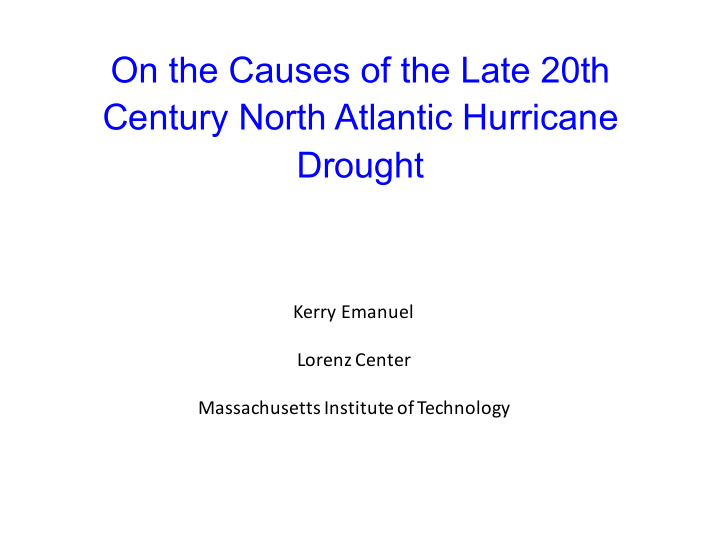



On the Causes of the Late 20th Century North Atlantic Hurricane Drought Kerry Emanuel Lorenz Center Massachusetts Institute of Technology
August-October Main Development Region (MDR) SST and Storm Lifetime Maximum Power Dissipation
U.S. Landfall Power Dissipation
Sulfate Aerosols and North Atlantic Hurricanes During the late 20 th Century, global aerosol radiative forcing is thought to be of the same order as CO 2 radiative forcing Per unit sea surface temperature change, shortwave forcing is roughly twice as effective as longwave forcing in changing potential intensity Much of the interannual variability of aerosol forcing over the tropical North Atlantic in summer is thought to be owing to the interaction of sulfate aerosols of European origin with African dust (Li-Jones and Prospero, 1998)
Variation of Potential Intensity with Ocean Heat Flux, Surface Wind Speed, CO 2 , and Solar Forcing Emanuel, K., and A. Sobel, 2013: Response of tropical sea surface temperature, precipitation, and tropical cyclone-related variables to changes in global and local forcing. J. Adv. Model. Earth Sys. , 5 , doi:10.1002/jame.20032
July Mean Sea Level Pressure
Annual European Sulfur Emissions
August-October MDR SST
Hypothesis: Multi-decadal variability of North Atlantic hurricane activity in the late 20 th Century is owing to variations in shortwave and longwave radiative forcing Residual quasi-decadal hurricane variability is owing to a natural oscillatory mode of the North Atlantic, nominally equivalent to the Atlantic Multi-Decadal Oscillation (AMO)
Test: Separate North Atlantic Storm Maximum Power Dissipation into two parts: a) Long-period variability (10-year running average) and b) quasi-decadal variability (residual) Use multiple linear regression to regress long-period signal onto 20-year lagged log(CO 2 ) and European sulfate emissions Correlate residual (quasi-decadal) signal in storm maximum power dissipation with North Atlantic potential intensity from NCEP reanalysis
Linearly regress European sulfates and log (CO 2 ) onto low- pass-filtered storm maximum power dissipation
Correlation between basin-integrated hurricane power dissipation and local potential intensity Map of r 2 between Storm Max PDI and NCEP PI 60 o N 0.6 48 o N 0.5 36 o N 0.4 24 o N 0.3 12 o N 0.2 0 o 0.1 1 0 0 o W 20 o W 80 o W o W 60 o W 40
Spectral peak at ~6 years
Correlation between basin-integrated hurricane power dissipation and local residual potential intensity
Multi-decadal Variability in 25 CMIP5 Climate Models Spectral peaks from 5 to 20 years From Ting et al, J. Climate, 2015 . Data courtesy Mingfang Ting.
CMIP5 multi-decadal signal regressed onto potential intensity From Ting et al, J. Climate, 2015 . Data courtesy Mingfang Ting.
Results from downscaling tropical cyclones from HADGEM2- ES, 1950-2005, 100 North Atlantic events per year
Summary A pronounced “hurricane drought” affected the North Atlantic from the 1960s through the early 1990s Hurricane power dissipation during this period was strongly inversely correlated with European sulfur emissions Spatial pattern of potential intensity projected onto hurricane power dissipation consistent with strong radiative forcing over the main development region Spatial pattern of residual potential intensity changes, with multi-decadal signal removed, consistent with CMIP5 signatures of Atlantic quasi-decadal natural variability Of 7 CMIP5 models downscaled, only the HADGEM model captures the Atlantic hurricane drought
Recommend
More recommend